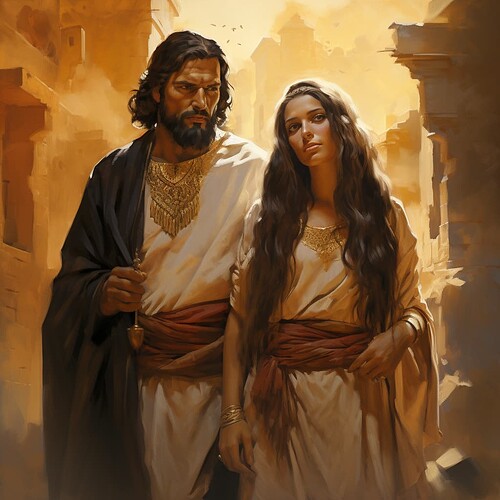Exploring the Complexities of Human Behavior and Divine Providence
 Introduction
Introduction
Today, we explore Genesis 38, a chapter that stands apart in the Joseph narrative, focusing on Judah and his daughter-in-law Tamar. This story, filled with moral complexities, sheds light on themes of failure, repentance, and redemption.
 Genesis 38: The Saga of Judah and Tamar
Genesis 38: The Saga of Judah and Tamar
Genesis 38 narrates the troubling and intricate story of Judah and Tamar. It reveals Judah’s failures as a father and individual, and Tamar’s daring actions to secure her place in Judah’s lineage.
Key Verse: “She is more righteous than I, since I wouldn’t give her to my son Shelah.” — Genesis 38:26
 Key Themes and Reflections:
Key Themes and Reflections:
Human Weakness and Moral Ambiguity: The chapter highlights the flawed nature of its characters, inviting reflection on human frailty and ethical complexity.
God’s Providence in Imperfect Situations: Despite human failings, God’s providential plan unfolds, evident in Tamar’s inclusion in the lineage of Christ.
The Quest for Justice and Dignity: Tamar’s story is a powerful testament to the pursuit of justice and personal dignity against societal norms and unfair treatment.
 Today’s Application:
Today’s Application:
Consider the ways we encounter and deal with moral ambiguities in our lives. Reflect on how God can work through our imperfections and the importance of seeking justice and dignity for ourselves and others.
 Hidden Gem:
Hidden Gem:
Did you know? The story of Judah and Tamar is crucial to the lineage of Jesus Christ, as mentioned in Matthew 1:3, demonstrating how God can use even flawed individuals in His grand design.
 Reflective Q&A:
Reflective Q&A:
![]() Genesis 38: Judah and Tamar’s Story
Genesis 38: Judah and Tamar’s Story
![]() Learning from Judah’s Failures: How does Judah’s story teach us about repentance and redemption?
Learning from Judah’s Failures: How does Judah’s story teach us about repentance and redemption?
A: Judah’s acknowledgment of his wrongdoing and Tamar’s righteousness shows a path to redemption through repentance and recognition of justice.
![]() Tamar’s Courageous Pursuit of Justice: What does Tamar’s story teach us about resilience and standing up for one’s rights?
Tamar’s Courageous Pursuit of Justice: What does Tamar’s story teach us about resilience and standing up for one’s rights?
A: Tamar’s story is a remarkable example of resilience and determination to claim her rights and secure her future in a patriarchal society, highlighting the importance of advocating for oneself.
 Join the Discussion:
Join the Discussion:
What insights do you gain from the complex characters and narratives in Genesis 38? How do you navigate moral complexities in your life? Share your perspectives in the comments below!
#Genesis38 #JudahAndTamar #MoralComplexity #Redemption #BibleStudy #SpiritualJourney
![]() See You Tomorrow in Genesis: Join us as we continue to unravel the rich tapestry of Genesis, discovering timeless lessons and divine interventions.
See You Tomorrow in Genesis: Join us as we continue to unravel the rich tapestry of Genesis, discovering timeless lessons and divine interventions.
 Join the forum!
Join the forum!
Participate in our AIgniteScripture Community for deeper insights and discussions:
Free Members: Engage in dynamic discussions and explore a variety of biblical resources. Register here: 🌟 How to Join Page - Membership Options
Supporters Membership ($20/month or $200/year): Gain access to exclusive content, newsletters, and special forum sections. Sign up as a Supporter: 🌟 How to Join Page - Membership Options
![]() Stay Updated with our AIgniteScripture Newsletter: Follow our daily reading journey and receive AI-enhanced biblical insights. Subscribe now: https://newsletter.aignitescripture.com/
Stay Updated with our AIgniteScripture Newsletter: Follow our daily reading journey and receive AI-enhanced biblical insights. Subscribe now: https://newsletter.aignitescripture.com/
